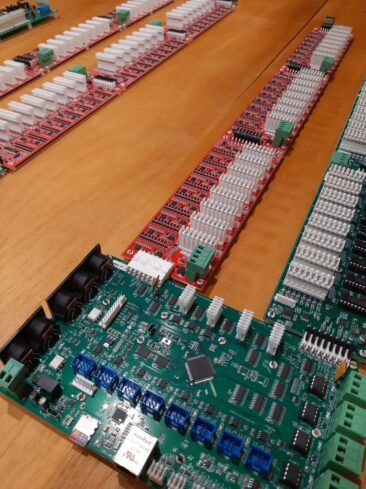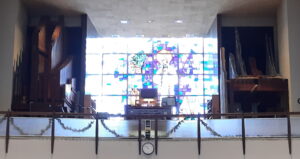
Welcome to the homepage for the renovation of the 1908 Wangerin pipe organ at St. John Vianney Catholic Church in Northlake, IL.
This page, and any pages added to it in the future, will explain the instrument, scope of the project, and progress updates.
I hope this may familiarize you with some basic aspects of the organ.
Please feel free to contact me with any questions!
1908 Hann-Wangerin-Weickhardt Pipe Organ
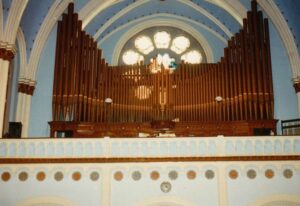
The H.W.W. organ was originally installed (1908) in the long closed (1990) St. Boniface Catholic Church near downtown Chicago. It was moved to St. John’s after the closure. During the move, some items were addressed such as the creation of a few windchests, and minor repairs to pipes, as well as the addition of some basic electronics and new wiring. However most of the organ was left in the condition it was found. Previous restoration work on this organ dates back to the 1970’s, when many of the chests were re-leathered. The console and other mechanics were updated sometime between the 1930’s and 1950’s. The organ was likely originally “tubular-pneumatic” (TP), meaning it was completely powered by air, rather than having electric controls. This design of organ quickly fell out of favor once electricity had been mastered in organbuilding. Very few remain, and for good reason.
The last major upgrades of the mid-20th century are now nearing the end of their useful lives. The mechanical components within the console are failing, and are not repairable. The leathers in the pipes, chests, and especially primaries are drying out, cracking, leaking, and failing in other ways. Decades of deferred maintenance are catching up with the organ. This project aims to get ahead of major failures, and also update the organ’s controls to modern computer-based systems.
This project is broken into several major phases, with work being broken up into the smallest possible sections, in order to keep the organ up and running throughout. This will drag out the length of the project, but will allow the organist to always use the organ. Most times, a project like this results in the organ being completely removed from the church for months or even years at a time.
While this page is only a summary of the work to be done, I hope it gives you a basic understanding of the project as a whole. You may also read a more formal proposal with this attached PDF.
Phase 1: Console
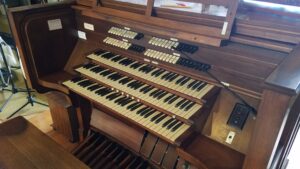
The 1950’s console will be gutted and upgraded with modern wiring and computer control systems. The existing keyboards and pedalboard will be refurbished. The current mechanical controls are failing and cumbersome. The computer controls will allow the organist virtually unlimited possibilities in terms of memory levels, presets, and the ability to incorporate digital extensions. Supply chain issues have much delayed this first phase of the project, but I anticipate completion before Summer 2023.
Phase 2: Divisions
“Divisions” of an organ refer to groups of pipes. For instance, the “Great” division is the primary group of pipes, composing the core sound of the organ.
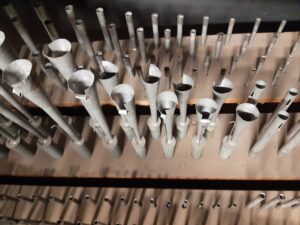
St. John’s, the Great division is what you see on the south side of the choir loft. This part of the project will deal with one division at a time, so that as much of the organ is available as possible. Work in this projects includes, but is not limited to:
- Pipe cleaning (all pipes) – There are 2,018 currently in this organ!
- Re-leather wooden stoppers (all pipes)
- Repair or replace wooden slides (all pipes)
- New, flared metal tuning sleeves (all pipes)
- Repairs, length adjustments, voicing corrections (as needed)
- The Oboe, Clarinet, Trumpet, and any other damaged pipes will be sent out for complete overhaul.
- Refurbish primary and stop actions (important – currently the source of many problems)
- Replace magnets (as needed)
- Wind leak mitigation (as needed)
- Rackboard and other wood repairs (as needed)
- General chamber cleaning
- Re-leather chest valves (optional or if deemed necessary upon inspection – the last re-leathering was in the 1970’s and is likely now approaching end of life. This can be done at a later time should funding be an issue.)
- (Optional) Addition of 16’ Reed and Chimes in CHOIR (chests exist for 16’ – no pipes) These were planned in the original installation.
Phase 3: Facade and Case
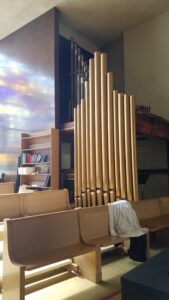
If possible, after the completion of phases 1 and 2, phase 3 will address the “beauty” of the instrument. Right now, half of the organ is just out in the open. Usually an organ like this is surrounded with a facade of wood and pipes. We are working to acquire a suitable facade from a closed church that would complement the organ and the church. This phase will also address accessibility and other safety issues throughout the organ.
Work completed as of March 2023:
- The wind pressure has been regulated throughout the organ.
- Oboe and clarinet pipes have been removed for major repairs (yet to be reinstalled), as well as several sets of small pipes that may be replaced with new or vintage stock.
- Work has begun on the console modernization, but has not been completed. (expected early Summer 2023)
- Several major air leaks have been addressed.
- Some voicing issues have been addressed ahead of schedule.
- A 16′ unit reed has been acquired, as well as a 25-note chime.
- Replaced faulty shade motor, and repaired weak linkages.
- Some notable repairs over the past few years, prior to the beginning of the project:
- Repaired many “dead” notes.
- Addressed noisy, whistling wind leaks.
- Raised pitch of the organ as close as possible to modern, standard pitch.
- Weekly regulation of worn out primaries (the cause of many ciphers; notes that will not turn off)
- Repaired leaky pipe stoppers.
Work Completed as of October 2024:
- Console finish repaired and cleaned
- Pedalboard cleaned, refinished, and releathered. Modern electrical contacts will be added later.
- The Oboe, Clarinet, and other pipes have been restored and reinstalled. (Removed since December 2022)
- Various continuing seasonal troubleshooting and maintenance items.
- Restoration of the 16′ Bombarde (a large bass reed, kind of like a trombone or tuba). More information to come!
- Coming soon:
- completed upgrades of organ electronic control system
- Beginning work on the Choir Division

